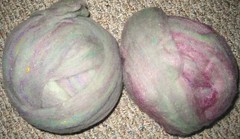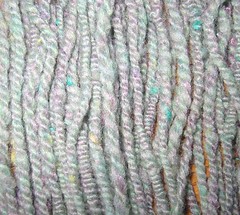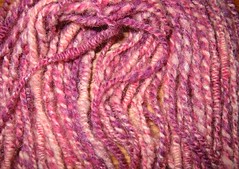
Recently I've been pondering how to spin a coil yarn. Pluckyfluff: A Handspun Revolution has terrific coil yarns, and my study group will get there -- eventually. Then, when I ran across coil yarn on etsy and could not resist (sigh), I had a real example in hand to touch, to examine, to aim for.
So, how do you spin coil yarn? First, you need to spin a fairly tight single yarn. It's best, too, if the singles have a smooth surface, not too lumpy-bumpy from neps, noil, scraps, or what-have-you. The tight twist comes in handy when creating the coils -- as you are coiling one single at a faster rate than the other, the uncoiled single comes quite close to being unspun. So, with more twist, you are that much further away from unspinning your single (whew!)
So, make your fairly-tightly-spun, fairly-smooth single. How thick? Depends what you want to aim for. But as coils are a surface texture thing, I'd recommend a thick-fingering to thin-DK single (say, not more than 20 WPI, not less than 15 WPI -- that's wraps per inch). Now, I did this with one ounce of fiber. Here's the first fiber and the first yarn:


Despite the fine wool/tencel texturing in the roving, or because of the tencel, this spun into a nice, smooth-surfaced single. Now the trick, I learned from this attempt, is all in how you coil.
To coil: you need to have both hands free, which means a wheel or alot of park-and-ply on a spindle. One single in one hand, against all the regular plying advice to hold them in the same hand for even tension. Why? Because we don't want even tension, we want coils!
Coil placement is the first thing -- how far apart to make the coils? If they are too far apart, they'll be lost in the yarn and in the finished project. Too close, and it may look like coil overkill, or the inner single won't have time to recover (though that can be managed too ...). I placed my coils about a foot apart -- sometimes a bit further, since I got a bit carried away at times in the regular plying (literally!)
For two-handed regular plying, I held both singles with the same tension, one in each hand, at mirrored angles from an invisible straight line coming out of the wheel's orifice (you can picture that, right?). I'd guess it was about 20 degrees each side of that line.
Then, when it was time to coil, I held the inner yarn straight along that line from orifice to me, and held the other yarn at a just-under 90 degree angle away from the inner yarn. So, if you took a protractor and measured the angle between the inner single and the outer single, it would be less than 90 degrees. Now, let the outer single wind around the inner single as you treadle. Hold the inner single taut so that it will not wind at all, but the outer single will wind around it. The slightly-less-than-90 angle is right if you are getting a millimeter or so (a visible gap!) between wraps. once you have a few wraps, stop and push them together.
Why don't you let them wind next to each other to start with? Because, if you stop and push them together, they bloom a little bit and make slightly bigger, more visible coils.
Do a few more wraps after the first push up and push up a second time, for the same coil.
Then, return the singles to their symmetrical positions and ply normally for a foot.
On the next coil, reverse which one is the inner and which is the outer! You'll note the above directions said nothing about handedness. So, if you used right-hand-outer-yarn the first time, now do the steps about with left-hand-outer-yarn. This balances out the over-untwisting of the inner yarn and the over-plying of the outer yarn.
Here is the fiber and second coil yarn:


This yarn was a little less smooth -- it has silk instead of tencel, and perhaps a crimpier fiber, since the surface of the single was not as shiny smooth as the first one. So the final coil yarn looks a little fuzzy on the surface, obscuring the coils a little bit. But the three colors in the roving counteract that nicely -- they play against one another, the contrast of marl-versus-solid shows off the coils.
Now, how do you make sure you have the right amount of plying twist for a balanced yarn? Clearly the coils will be highly overtwisted, that can't be helped. "Balancing" coils against one another helps to some extent. Also, since the singles are highly twisted, be sure to put enough twist in the regularly-plied parts of the yarn. It may look overtwisted -- just remember that singles allowed to sit for any length of time at all start setting their twist. Even five minutes makes a difference. Wash the skein in warm water and hang it to dry, and your slightly overtwisted yarn should balance back out.
See more about determining plying twist.
Curious about the blends used here? The purple-green is Viola Ville by Three Bags Full; see the whole Three Bags Full collection of lovely finewool/tencel blends including the divine Pearly White (coming soon!). The triple-pink is Montana Darby Dawn by Crosspatch Creations. There are many more lovely Triple-Play colorways by Crosspatch Creations that would also make lovely coil yarns.
Comments? questions? Have you tried a coil yarn? What advice do you have to pass on? comment here, trackback this entry on your blog, or email me: ask at thebellwether dot com.
